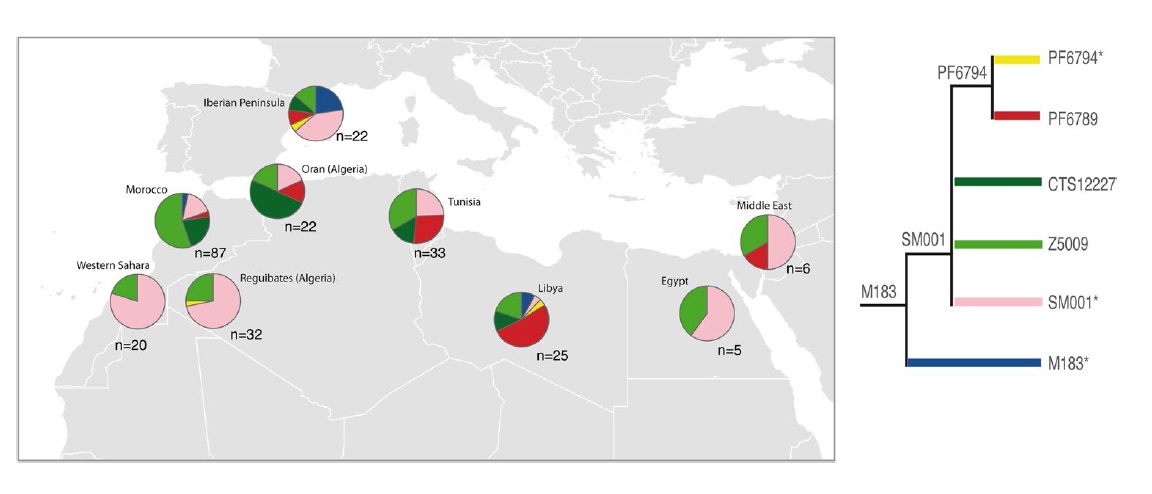Institut de Biologia Evolutiva - CSIC UPF
70% of Maghrebian men come from a common ancestor that lived only 2,500 years ago
This is the main outcome of a study published in Scientific Reports based on the analysis of more than 200 samples of men from the North of Africa, the Middle East and the Iberian peninsula. The analysis of the E-M183 Y-chromosomal variant sheds light to the historic and demographic processes that took place in the North of Africa. The E-M183 was found in Guanche mummies too, and such finding points northern Africa as the most likely region of the Canary aborigines’ origin.
 70% of Maghrebian men share a common ancestor, a sort of great-great-grandfather that lived 2,500 years ago. This is found in a study carried out by researchers from the Universitat Pompeu Fabra (UPF) and the Institute of Evolutionary Biology (IBE), a joint centre of the CSIC and the UPF, which was based on the genetic data from more than 200 volunteers from northern Africa, the Middle East and the Iberian Peninsula.
70% of Maghrebian men share a common ancestor, a sort of great-great-grandfather that lived 2,500 years ago. This is found in a study carried out by researchers from the Universitat Pompeu Fabra (UPF) and the Institute of Evolutionary Biology (IBE), a joint centre of the CSIC and the UPF, which was based on the genetic data from more than 200 volunteers from northern Africa, the Middle East and the Iberian Peninsula.
Since it is responsible for determining maleness and thus is transmitted from fathers to male offspring only, the Y chromosome is very useful to study the historic and demographic processes of the past. To shed light on the history of the northern African population, a team of researchers led by Francesc Calafell and David Comas analysed the E-M183 Y-chromosomal variant, which was found in 75% of Maghrebian men and is therefore the most frequent paternal lineage in the region.
Once the Y chromosome from North African E-M183 variant-carrier men was sequenced, scientists found out that the lineage is 2,500 years old. “Previous research suggested it originated in the Neolithic, that is, 4,500 years ago, or even in the Palaeolithic, 12,000 years ago; that is why such dating has been controversial within the scientific community”, Francesc Calafell, professor of the UPF and leader of the Genomics of Individuality research group of the IBE, says. “Such date shows that its origin is extremely recent, especially if we take into account the great mass of people that share this lineage.”
A very complex genetic scenario
As a result of several migrations and its cultural diversity, the genetic variety in Northern Africa is considerable. Different groups, Phoenicians, Romans, Vandals and Byzantines among them, have populated the region through history, and two different populations defined by their language coexist in the region: Arabians and Berebers.
The evolutionary history of the Y chromosome in humans seems to have happened in waves, and some variants have become more frequent due to cultural changes or technological innovations. “Our estimations of the E-M183 variant’s origin are in line with the end of the third Punic war, 146 BC, when Cartago (Tunisia now) was defeated and destroyed, and the Roman hegemony in the Mediterranean kicked off”, states Neus Solé, main author of the research recently published in Scientific Reports. “Approximately 2,000 years ago, the North of Africa was one of the richest Roman provinces, and quite probably this resulted in a demographic growth of the E-M183 variant.”
The E-M183 variant, found in the Canary Islands too
The E-M183 Y-chromosomal variant was also found in Guanche mummies, so it seems that northern Africa is the most likely origin of the aborigines of the Canary Islands. Given that the most ancient aborigine individuals had already been dated 2,200 years old, such findings back the hypothesis that the E-M183 sprang in the North of Africa.
“Data and mutation taxes used in this research reveal that the E-M183 variant emerged around 2,500 years ago in Maghreb”, concludes Calafell. For him, “this fits with the patterns observed in the rest of the genome, which show that an important mixing happened in the Middle East”.
Reference work: Neus Solé-Morata, Carla García-Fernández, Vadim Urasin, Asmahan Bekada,Karima Fadhlaoui-Zid, Pierre Zalloua, David Comas, Francesc Calafell. Whole Y-chromosome sequences reveal an extremely recent origin of the most common North African paternal lineage E-M183 (M81). Scientific Reports, Novembre 2017. DOI:10.1038/s41598-017-16271-y
Figure: Distribution of the E-M183 subgroups
